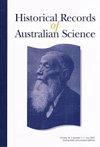John Gooden and the Birmingham proton synchrotron
IF 0.4
4区 哲学
Q4 HISTORY & PHILOSOPHY OF SCIENCE
引用次数: 0
Abstract
During World War 2, Sir Mark Oliphant began to plan for the construction of the world’s first proton synchrotron at the University of Birmingham. In March 1945, he offered a research fellowship to an enthusiastic and highly commended young physicist, John Stanley Gooden. Gooden had graduated from the University of Adelaide in 1941, and been working at the Radiophysics Laboratory, Sydney on radar research. With his wife, he arrived in Birmingham at the end of 1945, and immediately began work on the mathematical theory, design and construction of the proton accelerator. His enthusiasm and work ethic were infectious, and he soon became the project leader. In the latter part of 1947, Oliphant arranged for Gooden and John Fremlin to visit nuclear research facilities in the United States of America (USA) to gain knowledge about American plans for proton accelerators. They spent most of their time at the Radiation Laboratory, University of California, Berkeley and at Brookhaven National Laboratory, New York. The United Kingdom (UK) was exhausted after the war, and despite the best efforts of Gooden and Oliphant’s team, the construction of the synchrotron was slow. In 1947, Oliphant accepted a position as head of the Research School of Physical Sciences at the new Australian National University in Canberra. Gooden was the first staff appointment to the school. Oliphant planned to build a cyclosynchrotron at the university with Gooden as team leader. Tragically, in 1950, Gooden’s chronic nephritis deteriorated, and he died on 9 June 1950. Described by Oliphant as ‘my most brilliant student’, Gooden pioneered the theoretical basis and construction of the proton synchrotron. The Birmingham machine was finally completed in 1953, a year after the Brookhaven Cosmotron.约翰·古登和伯明翰质子同步加速器
第二次世界大战期间,马克·奥列芬特爵士开始计划在伯明翰大学建造世界上第一台质子同步加速器。1945年3月,他向一位热情而备受称赞的年轻物理学家约翰·斯坦利·古登提供了一份研究奖学金。古登于1941年毕业于阿德莱德大学,并一直在悉尼放射物理实验室从事雷达研究。1945年底,他和妻子来到伯明翰,立即开始了质子加速器的数学理论、设计和建造工作。他的热情和职业道德很有感染力,很快他就成为了项目负责人。1947年下半年,奥列芬特安排古登和约翰·弗雷姆林参观了美国的核研究设施,以了解美国的质子加速器计划。他们大部分时间都在加州大学伯克利分校的辐射实验室和纽约的布鲁克海文国家实验室度过。英国(UK)在战后已经筋疲力尽,尽管Gooden和Oliphant的团队尽了最大的努力,但同步加速器的建造速度很慢。1947年,奥列芬特接受了堪培拉新成立的澳大利亚国立大学物理科学研究学院院长的职位。古登是学校任命的第一个教职员。奥列芬特计划在大学里建造一个回旋同步加速器,由古登担任组长。不幸的是,1950年,古登的慢性肾炎恶化,他于1950年6月9日去世。古登被奥列芬特称为“我最杰出的学生”,他开创了质子同步加速器的理论基础和构造。伯明翰的机器最终于1953年完工,比布鲁克海文宇宙加速器晚了一年。
本文章由计算机程序翻译,如有差异,请以英文原文为准。
求助全文
约1分钟内获得全文
求助全文
来源期刊

Historical Records of Australian Science
HISTORY & PHILOSOPHY OF SCIENCE-
CiteScore
0.90
自引率
66.70%
发文量
22
期刊介绍:
Historical Records of Australian Science is a bi-annual journal that publishes two kinds of unsolicited manuscripts relating to the history of science, pure and applied, in Australia, New Zealand and the southwest Pacific.
Historical Articles–original scholarly pieces of peer-reviewed research
Historical Documents–either hitherto unpublished or obscurely published primary sources, along with a peer-reviewed scholarly introduction.
The first issue of the journal (under the title Records of the Australian Academy of Science), appeared in 1966, and the current name was adopted in 1980.
 求助内容:
求助内容: 应助结果提醒方式:
应助结果提醒方式:


